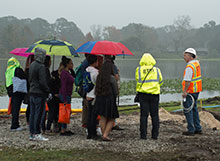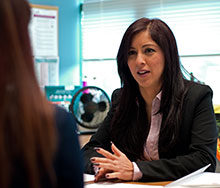|
|
|
|
Construction activities accelerate around Colonial Drive
Significant construction work is beginning in the Colonial Drive area as part of the 21-mile I-4 Ultimate project.
To build new Interstate 4 (I-4) ramps, Colonial Drive (S.R. 50) overpass and realign Garland Avenue, several upcoming closures are needed to move this area of the project forward.
The first major closure began the night of February 2. Colonial Drive is closed nightly from 10 p.m. to 5 a.m. (beginning each week on Sunday evening and ending Friday morning). The nightly closure continues until March 4. See detour
As a result of this bridge work at the Colonial Drive overpass, two ramps will be closed during work times: The westbound I-4 entrance ramp from westbound S.R. 50 and the eastbound I-4 entrance ramp from eastbound S.R. 50.
For more information about the nightly closure on Colonial Drive under I-4 visit I4Ultimate.com. Sign up to receive I-4 Ultimate construction alerts by email or text at I4Ultimate.com.
|
|
|
I-4 Ultimate Team Builds a Home for Ospreys
|
 |
When members of the I-4 Ultimate team inspected an overhead highway sign near Lake Ivanhoe they noticed it held an osprey nest.
The sign was scheduled to be removed as part of the 21-mile reconstruction of Interstate 4 (I-4). The nest did not have any eggs or young birds, but there was evidence of recent activity. That meant that action was necessary. The crew had been trained to deal with encounters with wildlife. They knew they had a duty to the birds, which are protected by the federal Migratory Bird Treaty Act.
“We knew we needed to do the right thing and follow all the guidelines,” said Brian Seecharan, Area 3 Project Engineer for SGL Constructors, the design-build joint venture for the I-4 Ultimate Project. “We were glad to be doing something for the environment.”
They consulted with Matt Baumann, environmental manager for SGL Constructors. Baumann said the team must build an alternative nesting platform at least 15 feet high and no more than 300 feet away from the original nest. After Baumann guided them in securing all the proper government permits, the team found a good spot beside Lake Ivanhoe. After some concerted effort, they found a five-foot-wide, concave, fiberglass dish. The dish was secured atop of an approximately 30-foot-long wooden pole, which was then set firmly in the ground.
Of course, there was no guarantee that the new structure would beckon the birds back. Then a couple weeks ago, the I-4 Ultimate team got good news. Seecharan was passing by the area, looked up at the big dish and spotted something that made him smile.
“I saw a bird there the other day,” he said. “They are using it. It made me really, really happy.”
|
|
|
High-tech Surveying Saves Time, Trouble, Dollars
|
 |
| |
Building the I-4 Ultimate project requires immense precision. Missing by an inch is equivalent to missing by a mile in this field of exact measurements. The difference between well done and a costly redo on the $2.3 billion project may be a matter of little more than the thickness of a nickel.
That’s where the high-tech survey team often helps guide the way. Whether the goal is to even the ground for a smooth roadway or stay within a precise boundary line for safety and efficiency, the survey team produces maps for others to follow during the reconstruction of 21 miles of Interstate 4 (I-4).
“We ultimately provide a 3-D model of the surface that can be viewed on computer screens,” said Steve Langley, Survey Manager for SGL Constructors, the design-build joint venture for the I-4 Ultimate project.
Remarkably, those screens aren’t only on the desks and smartphones that link together the designers, surveyors, field crews and managers. They also are installed in the cabs of heavy equipment operators. Take, for example, the person at the steering wheel of a grader, smoothing the ground for a new highway lane. The operator can view an icon on a built-in screen that shows the exact elevation of the ground and a line indicating the target level. That prevents them from digging down too deeply, which would mean hauling dirt and gravel back to the area and starting over – a very costly mistake. The computerized system also helps eliminate an extra round of traditional survey work.
Langley emphasizes that this is a team effort that starts with plans from designers. The survey team takes digitalized measurements and sharpens the plans down to tiny fractions of an inch, using specialized equipment and knowledge gained from being on the construction site. Indeed, the on-screen system can tell operators when they are within one-eighth of an inch of the target while paving an asphalt or concrete road. That’s about a nickel’s worth of difference that can save tens of thousands of dollars in do-overs.
|
|
|
1,400 Students Attend Central Florida Construction Career Days
|
 |
| |
Central Florida high school students turned out in large numbers for Construction Career Days to learn about opportunities in construction and transportation and try their hand at operating heavy machinery.
“I think this is amazing,” said Madelin Zubricky, a student at West Orange High School. “I wanted to learn more about construction, especially carpentry.” Zubricky especially enjoyed trying out many of the hand tools and heavy machinery. “The more you know, the better,” she said.
A total of 1,428 students from 46 high schools in Brevard, Lake, Orange, Osceola, Seminole and Volusia counties explored 34 Learning Labs, 12 Exhibitor Booths and had a chance to operate several pieces of equipment during the two-day event at Central Florida Fairgrounds in Orlando.
The 16th Annual Construction Career Days, hosted by industry partners and the Florida Department of Transportation (FDOT) , gave juniors and seniors from Central Florida high schools a chance to learn about job opportunities, ranging from hands-on construction to computer-based engineering.
In addition, students interested in those fields have a chance to win a $1,000 scholarship to put toward schooling or training. Up to six students – one from each of the participating counties – will be selected as winners. For more information, visit: http://ccdfl.com/scholarships/scholarship-central.php
“Construction Career Days is a great way to introduce the builders of tomorrow to our industry,” said Dee Zinck, FDOT’s District Construction Administrative Manager and Construction Career Days Co-Chair.
Brandhon Sweeney, a student at Winter Park High School, said it was exciting to learn about various career paths in engineering and to try out some of the computer programs. “It opens your mind.”
The students were accompanied by career specialists from their schools and a total of 176 chaperones during the two-day event. Two co-chairs and approximately 25 committee members started planning the event six months in advance. Each day about 130 volunteers guided the students to their assigned labs and nearly 30 equipment operators supervised those who wanted to try out the equipment.
|
|
|
Employee Spotlight: Lisbeth Acosta
LISBETH ACOSTA
Human Resources Coordinator
Resident of Altamonte Springs
Helping to blend the diverse staff and multiple corporate cultures of the I-4 Ultimate workforce into one team is an exciting challenge for Lisbeth Acosta, the project’s Human Resources Coordinator.
She loves seeing how dedication to the success of Florida’s largest public-private partnership inspires teamwork. “Even though there are people from many companies in our building, it’s hard to tell them apart,” Acosta said. “They collaborate and work together as teammates.”
Acosta enjoys being in the busy I-4 Ultimate headquarters in Maitland and realizing that while the engineers, designers, financial analysts, heavy machinery experts, traffic managers and others come from many companies and many places, they all seek the same goal: Increase safety and mobility on Interstate 4 (I-4).
Born in Ecuador, Acosta grew up and went to middle school and high school in New York. She was working with Skanska on an office construction project in Brooklyn when she heard about the $2.3 billion project to rebuild 21-miles of (I-4) in Central Florida.
She applied for a job to expand her professional and personal horizons. “This is my first chance to work on a highway project, and I’m learning a lot. I also get an opportunity to appreciate the perspectives of people from several companies.”
One of her next goals is to see how the team manages traffic shifts and lane closures at night and experience what it’s like to work on the interstate during those times. “I get to interact with many departments and get to understand their jobs better,” Acosta said.
Acosta, who lives in Altamonte Springs, likes to use her spare time to play tennis, practice yoga, travel and do ballroom dancing. She even performs occasionally as a ballroom dancer at Bongos Cuban Cafe in Disney Springs.
|
|
|
|
|
|
Public participation is solicited without regard to race, color, national origin, age, sex, religion, disability or family status. Persons who require special accommodations under the Americans with Disabilities Act or persons who require translation services (free of charge) should contact Jennifer Smith, FDOT Title VI Coordinator by phone at (386) 943-5367, or via email at jennifer.smith2@dot.state.fl.us. If you are hearing or speech impaired, please contact us by using the Florida Relay Service, 1-800-955-8771 (TDD) or 1-800-955-8770 (Voice). |













